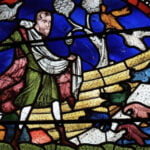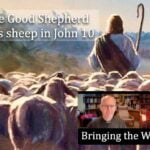The gospel lectionary reading for Trinity 2 in Year B is Mark 4.26–34. Once again, the lectionary makes a slightly odd choice, picking up the teaching of Jesus midway through a sequence of pericopes mostly related to parables and the kingdom. But it contains one of my favourite images in the teaching of Jesus, unique to Mark, and includes one of my favourite words in the whole New Testament—which occurs only here and in Acts 12.10.
The immediate context of our reading is the parable of the sower and the soils, together with the explanation in private to the disciples, and its use as a ‘parable about parables’, in which Jesus explains why he teaches in a cryptic way. We will not be reading it from Mark, as it is omitted from the lectionary for Year B, I assume because we read it from Matthew 13 last year. But putting it as the first substantial element of Jesus’ public teaching, Mark emphasises how important it is a key for understanding all of Jesus’ teaching: those on the ‘outside’ are offered a tantalising glimpse of what the kingdom means, whilst those on the ‘inside’ are offered full understanding. The question then is whether the outsiders will be sufficiently intrigued to seek to become insiders.
The prominence of this idea gave rise to the notion of the ‘Messianic secret’ in Mark. William Wrede argued in 1901 that Jesus was a failed apocalyptic prophet who had not persuaded the Jews as a whole to follow him, and that without the Hellenised work of Paul, Christianity would be just another failed Jewish sect. He believed that the gospel of Mark was written as a way of explaining this failure, so that the ‘insider/outsider’ distinction explained why the outsiders did not recognise Jesus, and that Mark claims his miracles were mostly performed in private, which is why they did not challenge people. Wrede’s historical scepticism is not warranted here, and is a reflection of his intellectual time more than anything else. But it does draw attention to the importance of this theme in Mark, so (for example) we do find Jesus healing, delivering and raising people in private (Mark 5.40, 7.33, 8.23), which reflects his focus on compassion rather than public performance. Jesus both silences demons (Mark 1.25, 3.12) and tells those he has healed not to tell anyone (Mark 1.44, 7.36) and the main part of the gospel ends with the women at the tomb running and ‘telling no-one, for they were afraid’ (Mark 16.8).
Wrede’s thesis fails as an account of the text, since it is clear from the beginning that some of Jesus’ miracles are indeed done in public—and the ‘insiders’ who are given the explanation themselves often do not understand who Jesus is or what he has done, even though they have an advantage. However, ‘from a literary perspective, this gospel conveys a strong sense that there is a mystery for the reader to solve’ (Mary Ann Beavis, Paideia, p 80). For those within the story, encountering Jesus (the ‘first level’ of the narrative), they can see something has happened that calls for explanation and response. For the first audience of the gospel (the ‘second level’ of the narrative), they can see in the Jesus movement that something has happened that calls for explanation and response. Perhaps this is also a helpful pattern of testimony for us as later readers (the ‘third level’ of the narrative…?).
The passage itself is quite short, and is comprised of two concise parables, both offered without explanation, followed by a summary comment on the importance of parables in Jesus’ teaching, which concludes this whole section of Mark 4.1–34. It is followed by Jesus stilling the storm on the lake before stilling the storm of the demon-possessed man.
The parables are connected by the repetition of the simple phrase ‘And he said…’ kai elegen, which links the different elements of this section together: in his teaching, ‘he said to them’ (Mark 4.2); when he was alone with the disciples, ‘he said to them…’ (Mark 4.11); and the phrase is repeated in Mark 4.13 (with a slight variation of the historic present rather than past tense), 4.21, 4.24, and in our passage at Mark 4.26 and 30. Many ETs try to add interest by varying the form of the translation (‘He said…he also said…Again he said…’ and so on), but this simple repetition both fits with Mark’s paratactical style of writing—simply placing different sections next to one another—and serves to thread these different elements and hold them together quite tightly.
The first parable has the briefest of introductions: ‘the kingdom of God is like…’. Since we are not given the explanation (which, on the basis of Mark 4.34, he did give to the disciples, but Mark just didn’t include it), the parable functions in a way that is quite close to many of Jesus’ cryptic sayings in the Fourth Gospel, where the literal meaning provides the illustration of the thing that is pointed to in the symbolic reading. In her commentary, Mary Ann Beavis distinguishes between ‘allegories’ (like the parable of the sower and soils) and ‘parables’, the former offering detailed parallels between story and application, the latter being more general. I am not sure that this distinction really works, since even in the ‘allegories’ there is not a clear one-to-one correspondence between one element and its application—are the believers the seeds that grow into plants, or the soil that receives the seed?
This parable has a number of quite specific connections with the sower and soils: a man ‘throws’ or ‘scatters’ seed (ballo) suggesting the kind of ‘broadcasting’ (rather than careful sowing in a drill) that we see in the first parable. The threefold description of the growth of the seed ‘first the blade, then the ear, then the full grain in the ear’ provides an echo of the threefold description of the seed bearing fruit ‘thirty and sixty and a hundred’ (Mark 4.20).
But the central theme of this parable is almost the opposite to the message of the first. The sower and soils does imply the sovereign work of God, in that the sower simply scatters the seed, but even here there is a challenge to human action and initiative: will those on the inside, to whom the secret of the kingdom has been given, in turn become sowers of the word-seed? And the challenge to the outsiders is: which kind of soil will you be? Will this word you are hearing be something that takes root, is not snatched away, or scorched, or strangled, but bears fruit for you and then others?
However, in this parable Jesus is emphatic: night and day (counted in the Jewish sense from evening to morning, rather than our way of counting days from morning to evening) the man simply rises and goes to sleep, without the slightest hint of any effort on his part. In fact, not only does he do nothing, but the growth of the seed is a complete mystery to him! Nothing is needed here, except that the seed makes contact with the earth.
This is where we find my favourite word in the New Testament: αὐτομάτη, the feminine of automatos, from which of course we get ‘automatic’. The earth (with the seed planted in it) produces the fruitful result ‘all by itself’, without any human intervention. The other place where this word occurs is in Acts 12.10, when Peter is miraculously released from prison, and the gate opens ‘all by itself’. In both cases we have a sense of ‘divine passive’; what appears to happen automatically is in fact a result of God’s sovereign action.
In the parallel collection in Matthew 13, where Matthew includes his own unique parables of Jesus, the treasure in the field and the pearl beyond price, I noted that there is a tension between whether the kingdom comes about because of God’s sovereign initiative, or because of human response. In other words, does it all depend on God, or all depend on us? Taking all the parables together, the answer is surely ‘Yes! Both!’ and Paul sums this up rather well as ‘I sowed, and Apollos watered, but God gave the growth’ (1 Cor 3.6). This does, indeed, reflect the reality of farming on a large or small scale; there is a sense of wonder that fruitful plants grow miraculously from tiny seeds. But not all gardens, or farms, are equally fruitful!
Given that Jesus tells parables with one focus or the other, it is worth pausing on this parable, and asking whether this is a particular word we need to hear in this season. Like other western denominations, the Church of England, in which I am ordained, is obsessed with Mission Action Plans, strategies, church planting, and reorganisation. All these things are needed—but the danger is that these things give the false impression that, if only we got our strategies right, then the growth of the kingdom will come. This parable, and the central term αὐτομάτη, tells us that this is a lie. The kingdom of God will grow because God is sovereign, and Jesus is Lord, not because of any resolutions of Synod, grants of funding, or strategies of dioceses.
In relation to our second parable, there is often some debate in commentators about exactly which variety of ‘mustard’ Jesus is referring to here, whether it really is the smallest of all seeds, and whether it can really grow to be the size of a tree. But in the end these miss the rhetorical point of the exaggeration of the parabolic form; mustard is proverbially small, and black mustard (brassica nigra) can in fact grow to be several metres tall. (This is also a wider feature of polemical language; it was not literally true, as Jesus predicted, that ‘not one stone of the temple will be left on another’ [Mar 13.2] since you can still see today some stones of the lower wall of the Second Temple, and share the wonder of the disciples at their size and majesty.)
The surprising nature of something substantial growing from something small is actually a feature of all gardening and cultivation. I have just sown and pricked out my second crop of lettuce, and it is a constant surprise to see something so small—almost too small to handle—eventually provide an abundance of food. The kingdom of God seems at first to be something small and insignificant—small seeds are almost as fine as dust, and just as easily blown away or lost—but there will come a time when, like the plants that seeds produce, it is impossible to ignore.
To the keen eared who are soaked in the Old Testament, there is an echo here of the language of Nebuchadnezzar’s dream and its interpretation by Daniel in Daniel 4.12, 21. The kingdom of Babylon is like a tree, and the birds in its branches are the nations who become subject to it. This is not unconnected with the subject of the kingdom of God/heaven, since in chapters 2 and 7 we have visions of how the ‘kingdom of the God of heaven’ will destroy the four great kingdoms of this world [Babylon, Persia, Greece and Rome], depicted as a four-stage statue or four beasts emerging from the ‘sea’ of the peoples of earth.
There is no justification for seeing the image of a large tree as pointing to the (historical) triumph of the institution of the church growing and dominating culture. This organic image refers to the kingdom of God in all its diversity, not any one or collection of institutions.
But this parable reminds us of the saying in Zechariah 4.10: ‘Do not despite the day of small things’. Zechariah’s is a time of the end of exile, yet when the newly settled people of God, returning to the land, saw the work of renewal God was doing as weak and fragile, exposed to all sorts of dangers. The renewal movement found in the ministry of Jesus and his first followers must also have seemed fragile, as Jesus preached the end of the exile of sin, and the return of the people of God not to the land, but to the temple that was Jesus himself. This small seed grows into a large tree ‘all by itself’, because of the sovereign power of God. And the results of this will be seen only at the end, at the time of harvest, when someone ‘puts in the sickle’ (Mark 4.29).
Until then, we must wait and see…





























You can still see today some stones of the lower wall of the Second Temple. To the best of my knowledge, this wall was support for the whole temple area. Nothing remains of the Second Temple itself.
I agree that Mission Action Plans, strategies, church planting etc should not overlook the truth that the kingdom of God will grow because God is sovereign – if it is a truth. My caveat arises from observing that the kingdom of God is not growing in the UK, but shrinking. Hardly anyone is getting converted, and the average age of church-goers is over 65 and rising. Possibilities: the ground is exceptionally infertile, we are doing nothing to counteract its infertility (by manuring it, Luke 13:8), we are not sowing any seed, we are not sowing the right kind of seed. I get little sense that the kingdom is growing automatically.
I remember the local vicar comforting himself for the relentless shrinking of his own congregation with the words, “I will build my Church, and the gates of Hades will not prevail against it.’ I put it to him that Jesus was saying he would build his Church even if persecution was so intense that believers would be killed because of their faith.
The video presented in your previous post continues to be of relevance, I feel.
Thank you, again. I will be pointing the new curate to your resources for sermon preparation. I agree that there is generally a growing lack of biblical knowledge, deeper than the Sunday School or Little Jack Horner (pull out a stray plum – ignore the rest) variety, and weaving the literary, theological, historical with the immediately spiritual is an ongoing task for us all.
The preacher has a challenge first to teach but then also instil a curiosity about Scripture, and most of all, to demonstrate that this is a living Word, God-breathed, not a cross-word puzzle, an arcane set of ancient texts, or a playground for argumentative bullies.
The birds that will nest in the branches would presumably have happily eaten the seeds! What hospitality! For this parable Ched Myers links back not just to Daniel but to Ezekiel 31, where Egypt is cut down despite its great height – but the new community of Jesus followers will become the hospitable centre. He suggests a political edge to these verses.
I would venture to say that these days, children in sunday school can have a far better insight into the overarching story of God portrayed throughout scripture than many in the pews.
but agree with Steven that the seed is not landing wide enough.